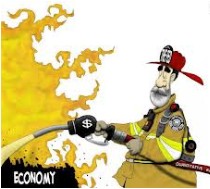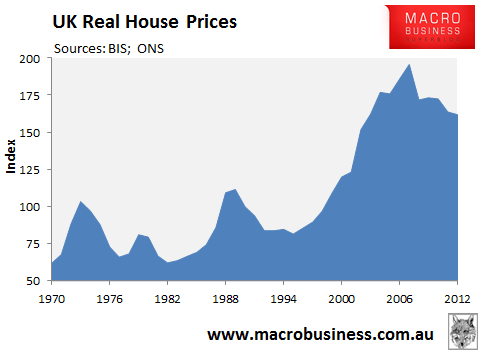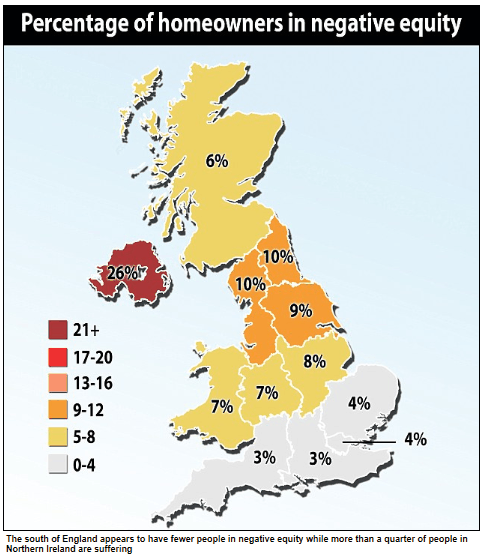
The fallout from the UK’s £130 billion of government mortgage guarantees (dubbed the “Help to Buy Scheme”), announced last week in the Budget, has continued with the Office of Budget Responsibility (OBR) – the Government’s favoured economic forecaster – slamming the proposal, arguing that it would simply inflate house prices without significantly contributing to new home construction. From the Guardian:
The government’s favoured economic forecaster said the Help to Buy scheme – which was one of the biggest announcements in the chancellor’s budget speech – would push up asking prices instead of encouraging housebuilders to start building new homes.
The OBR’s warning comes after the former chancellor Alistair Darling accused the government of stoking another housing bubble that could sow the seeds of a US-style subprime mortgage crisis…
The OBR said on Tuesday that the scheme would do little to boost the construction industry but was likely to inflate property prices.
Prof Stephen Nickell, a member of the OBR, told the Treasury select committee: “The key is: is it just going to drive up house prices? By and large, in the short run the answer to that is yes. But in the medium term will the increased house prices stimulate more housebuilding, and our general answer to that would probably be: a bit. But the historical evidence suggests not very much.”
The committee’s chairman, Andrew Tyrie, noted that the scheme was supposed to last three years, so any medium-term benefits would emerge only as the programme was being wound up.
The OBR also correctly noted that there would be minimal construction response, and affordability would remain stretched, as long as the UK planning system remained highly restrictive:
The OBR chairman, Robert Chote, said strict planning laws limited housebuilders’ ability to build more homes, so the Help to Buy scheme was more likely to push up prices than increase the supply of new housing.
“If you were to note the fact that the planning system remains an important reason why the supply of new housing is relatively inelastic [and] the need of housebuilders for working capital, I suspect that more of it would have shown up in prices than in quantities”…
On Monday Darling told parliament that house prices would carry on rising unless more houses were built. “The irony is we are not prepared to build houses but we are prepared to stoke the finance of a bubble in housing prices, and that seems to me to be absolutely wrong.”
Meanwhile, as the Government moves to stoke mortgage demand, its efforts to free-up the supply-side continue to be stymied, with the House of Lords voting down a proposal to allow homeowners to expand their floor area without planning permission, as well as heritage groups stepping-up their lobbying against proposed Government reforms aimed at promoting sustainable development. From the Telegraph:
The leaders of the two biggest countryside campaigns are warning that planning reforms coming into force will “wreck the countryside” and leave large parts of England at their most vulnerable to builders for 70 years…
The news came as government plans to allow home owners to double the size of ground floor extensions without planning permission were rejected by the Lords.
The new national planning policy framework, which came into force on Tuesday night, requires councils to promote “sustainable development” in planning decisions.
The 52-page NPPF – which replaces more than 1,400 pages of existing guidance – was bitterly opposed by rural campaigners and readers of the Telegraph through its “Hands Off Our Land” campaign.
Sir Andrew Motion, a former poet laureate and chairman of the Campaign to Protect Rural England, suggested the change would “wreck the countryside”.
He said the NPPF was “proving to be ground breaking in all the wrong ways”, adding: “Developing greenfield sites unnecessarily and with inadequate local consultation is entirely the wrong way to make sure that we get the new homes the country so badly needs.
“This is a charter for builders and truly irreversible damage is already underway. It is urgent that something is done about it.”
Sir Simon Jenkins, the chairman of the National Trust, said: “The majority of the English countryside which is not designated for protection is now to be released for development to a degree that we have not experienced since the 1940s.
“That is clearly the case and this is very sad. It just means we are moving away from planning of any sort towards a building permit system as in Ireland”…
But [Local Government secretary] Mr Pickles warned that people will be condemned to “rabbit hutch houses” unless the planning reforms were allowed to work and development allowed.
To say that the UK housing system is a disaster is an understatement. Sixty years of urban consolidation policies and strict planning, combined with decades of easy credit, have caused prices to escalate, as well as display high levels of volatility, as evidenced by the UK experiencing four boom/bust cycles since the 1970s (see next chart).

The forced urban consolidation (‘cramming’) caused by the UK planning system – whereby only 8% of the UK is urbanised, compared with roughly 28% in Germany, 20% in Italy, 28% in the Netherlands, 18% in Switzerland, and 9% in Spain – is also causing significant localised pollution problems, with asthma and other respiritory diseases on the rise across the UK. From the Guardian:
The last few weeks have been stressful for many of the 5.4 million people, including 1.1 million children, who are receiving treatment for asthma and for the tens of thousands of others with respiratory diseases. Since Christmas, there have been four major air pollution episodes, stretching from London to Nottingham, Birmingham, Leeds, Dundee and Glasgow…
Dr Ian Mudway, a lecturer in respiratory toxicology with the environmental research group at King’s College London university, has spent several years walking the routes that children take to school in the London Borough of Tower Hamlets, measuring the pollutants in the air they breathe and determining their impacts on their respiratory health. He is shocked at the levels of pollutants these children are exposed to on a daily basis and fears for the permanent damage being done by to their lungs by the ultra-fine particles and gases emitted by diesel engines.
East London has long been heavily polluted by industry but Tower Hamlets has some of the busiest roads in Britain passing close to large high-density housing estates. Nowhere in the borough is further than 500 metres from a busy road and new housing developments targeted at young families are popping up right by main roads…
The latest figures suggest 29,000 people die prematurely from it every year in Britain, twice as many as from road traffic, obesity and alcohol combined, and that air pollution is now second only to smoking as a cause of death…
London, with 4,300 deaths a year, is one of the worst in Europe and the pollution monitor on Marylebone Road shows the fourth highest levels of NO2 of over 2,000 monitoring stations in Europe. The city has 2,500 schools and 180,000 children within 150m of roads carrying 10,000 or more vehicles a day.
Finally, the dysfunctional UK housing system is also causing many homeowners significant pain, with the the Financial Conduct Authority revealing that 630,000 households are facing negative equity, whereas the Council of Mortgage Lenders claims the figure is closer to 800,000, with the highest proportion of negative equity households located in the north (see below map from the Daily Mail).

The UK experience provides a salutary lesson for Australia of what can happen when government policy works to continually pump housing demand whilst simultaneously choking supply.

